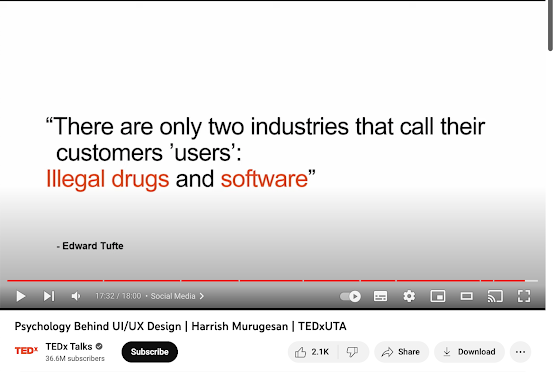For this blog post I researched multiple sources and came across a Forbes article titled “12 Best Practices For Great UX Features On A Website” written by a Forbes Business Council member and on YouTube a Ted Talk titled “Psychology Behind UI/UX Design | Harrish Murugesan | TEDxUTA”.
For someone that has no experience with website development the Forbes article is the perfect start to this journey. As a third-year creative digital media student I found myself relating to most of the points in this article. I found that their fourth point about communicating directly with your users stands out the most to me as from my experience I see that my fellow students never made a survey. I am guilty of this, and I have not seen the importance of this until now. Testing UX on a separate web page that you create is an excellent point because with my experience when I was a beginner learning how to implement different things, I would mess up my code or organisation by testing my UX on my actual project.
If you want to get more advanced the ted talk is the perfect next step. Every point the speaker made was new to me and lots of things stood out. The terms the speaker used will be something I will look over in the notes I took down as I listened to what he was saying. I never realised colour was so important when he mentioned that T-Mobile sued companies overusing a similar shade of magenta. Although minimalism can seem like too little work when it comes to creating a website if you go overboard there is something called Cognitive Overload. This is the stress you are putting on yourself when you are trying to learn new information. He showed us the most popular apps in grey colours and then showed us them again in colour and made us think about how we felt. He noted that our dopamine levels increased. Something that can help you when you are doing ux is thinking about the responsiveness. Us humans thrive with communication so naturally we want our websites to be more responsiveness. In the talk the speaker uses the example of liking a picture and getting a little vibration. This is called Positive Reinforcement. Making a little reward system like this will make your users want to stay on your website. The talker mentioned that when you dislike a post you do not get a reward or a nice vibration or any sort because they do not associate this with negativity. This was my favourite point out of the two sources I used because us students do not incorporate subtle things like this but after this talk, I will be looking forward to trying this out myself. The last thing that the speaker mentioned was when he used the example between the search engines Google and Yahoo. Both have the same functions, but Google is more successful because of the processing/ perception fluency- this is when easier to process content is seen is trustworthy. Google used more colours in their logo and is centred while Yahoo is too clustered, and the search bar is not the first thing you see. I learned from this point, and I feel like this is yet another point students should note when making websites. Lastly, I would like to note the quote he used at the end that you should keep in mind when creating websites: “” There are only two industries that call their customers ‘users’: Illegal drugs and software.”- Edward Tufte.” I think the app that is missing in all the sources I have looked through is TikTok. This app is unique and innovative, yet nobody is breaking down their success. Addiction and targeting the dopamine system should be the priority. When you research about UX it is evidently better to watch a video just like the ted talk source I used as it is more communicative and you will grasp a greater understanding.

In conclusion after studying through the Forbes article and a Ted Talk YouTube video my points were that beginner developers looking to use UX should investigate the Forbes article first and then the video but researching this topic is better with videos as you absorb more of the information in. The main points that I focused on were communicating with your customers through example: surveys, testing your UX on a separate page, the terms the ted talk speaker used are helpful, how important colour is, minimalism and cognitive overload, giving your website a reward system after a positive action- this is positive reinforcement and in increase in responsiveness in your website, process/ perception fluency and how easier to look at content is seen as more trustworthy example Google. Lastly I commented on the example that most of the sources I looked for never included TikTok as an example to go through and how addiction and targeting the dopamine system are a priority.








